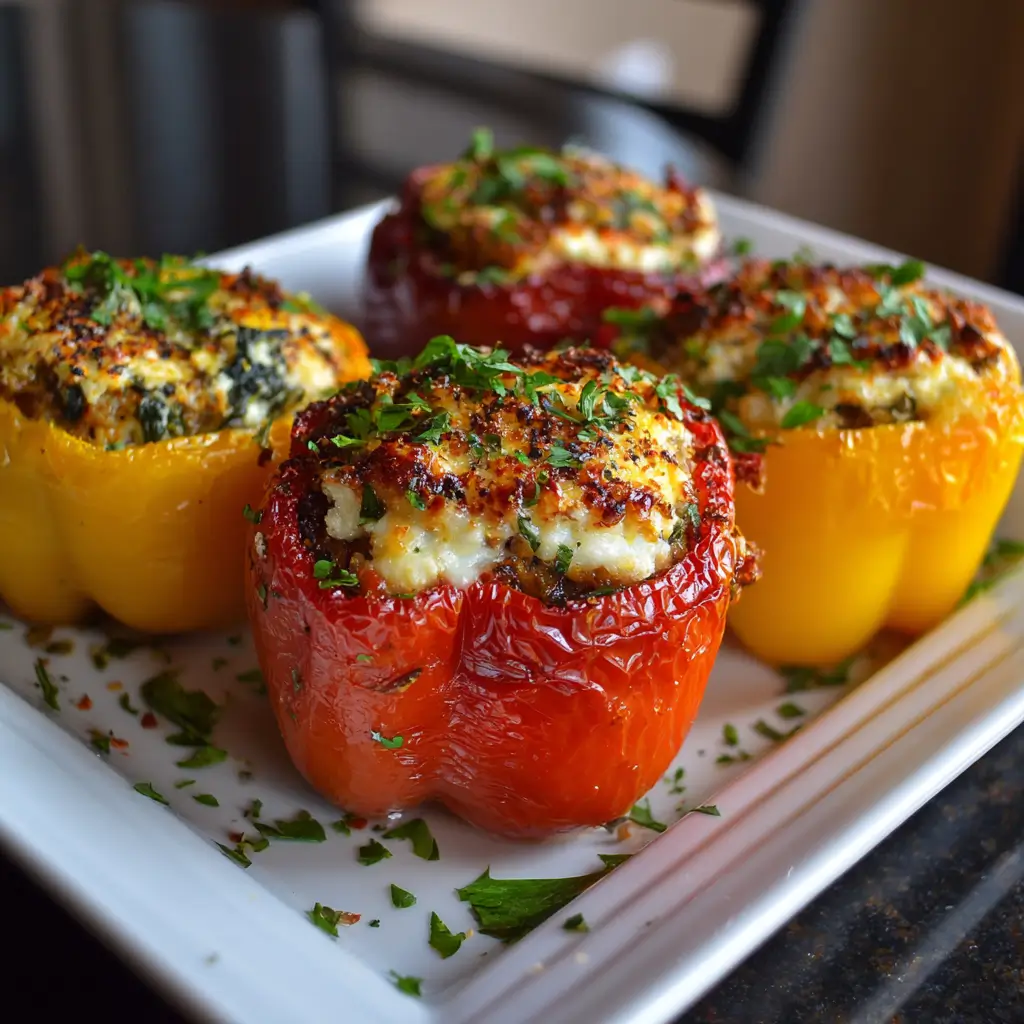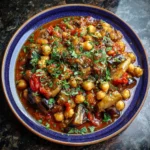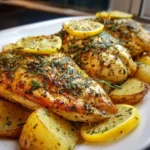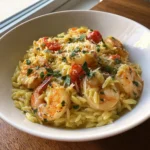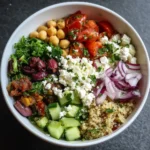Mediterranean Stuffed Bell Peppers
There’s something uniquely satisfying about a dish that brings together vibrant colors, bold flavors, and wholesome ingredients. Enter the Mediterranean Stuffed Bell Peppers — a culinary masterpiece that marries the natural sweetness of bell peppers with a rich medley of grains, herbs, vegetables, and protein inspired by the sun-kissed shores of the Mediterranean Sea. Whether served as a hearty main course or an elegant dinner centerpiece, these stuffed peppers are nutritious, flavorful, and visually stunning. They’re perfect for weeknight dinners, meal prepping, holiday gatherings, or impressing guests with minimal effort. This guide dives deep into every aspect of this beloved dish — from its historical roots to step-by-step preparation, health benefits, variations, and expert tips — so you can master it with confidence and creativity.
The History
The concept of stuffing vegetables is ancient and spans across numerous cultures, particularly in regions surrounding the Mediterranean Basin. Countries like Greece, Turkey, Lebanon, Italy, and Spain have long traditions of preparing “dolma” or “yalancı dolma” (meaning “fake dolma”), where vegetables such as grape leaves, zucchini, eggplants, tomatoes, and bell peppers are filled with seasoned rice, herbs, and sometimes meat. The term “dolma” comes from the Turkish word “doldurmak,” meaning “to fill.”
Stuffed bell peppers specifically gained popularity in the 20th century, especially as bell peppers became more widely cultivated and available year-round. In Greece, they are known as “gemista” — oven-baked vegetables stuffed with a savory mixture of rice, tomatoes, onions, and fresh herbs like dill and mint. Similarly, in Southern Italy, “peperoni ripieni” often feature a blend of breadcrumbs, cheese, ground meat, and parsley baked until golden.
Over time, this humble dish has evolved, adapting to regional tastes, dietary preferences, and modern nutritional trends. Today’s version often emphasizes plant-based ingredients, whole grains, and heart-healthy fats, aligning perfectly with the principles of the Mediterranean diet — one of the most celebrated and scientifically supported eating patterns for longevity and wellness.
Ingredients Breakdown
What makes Mediterranean Stuffed Bell Peppers both delicious and nutritious lies in the careful selection of ingredients, each contributing flavor, texture, color, and health benefits. Here’s a detailed look at what goes into this dish:
- Bell Peppers: Choose large, firm bell peppers in a variety of colors — red, yellow, orange, and green. Red peppers are the sweetest and richest in vitamin C and antioxidants like lycopene and beta-carotene. Their sturdy walls hold up well during baking without collapsing.
- Olive Oil: A cornerstone of Mediterranean cuisine, extra virgin olive oil adds richness, depth, and heart-healthy monounsaturated fats. It also helps carry the flavors of herbs and spices throughout the filling.
- Aromatics (Onion & Garlic): Finely diced onion and minced garlic form the flavor base. When sautéed, they release sweetness and umami, enhancing the overall complexity of the stuffing.
- Whole Grain (Quinoa or Brown Rice): Cooked quinoa or brown rice provides a chewy texture and sustained energy. Quinoa is a complete protein, while brown rice offers fiber and B vitamins. Both are excellent gluten-free options.
- Chopped Tomatoes: Use fresh ripe tomatoes, canned diced tomatoes, or fire-roasted tomatoes for tanginess and moisture. Tomatoes are rich in lycopene, especially when cooked with oil, increasing bioavailability.
- Kalamata Olives: These briny, purple olives add a signature Mediterranean flair. Pitted and chopped, they contribute healthy fats and a savory punch.
- Feta Cheese: Crumbled feta delivers creaminess and saltiness. Made from sheep’s or goat’s milk, it’s lower in lactose and higher in flavor than many cheeses. For a vegan version, use dairy-free feta alternatives.
- Fresh Herbs: Parsley, oregano, mint, or dill are commonly used. Fresh herbs not only brighten the dish but also offer antioxidant and anti-inflammatory properties.
- Lemon Juice: A splash of lemon juice balances the richness and enhances other flavors through acidity.
- Pine Nuts or Walnuts: Toasted pine nuts add crunch and luxury, while walnuts provide omega-3 fatty acids and a more affordable nut option.
- Spices: Ground cumin, paprika, black pepper, and cinnamon (a hint) deepen the flavor profile, adding warmth and complexity typical of Levantine cooking.
- Vegetable or Chicken Broth: Used to moisten the stuffing and prevent dryness during baking. Low-sodium broth ensures control over salt levels.
- Optional Add-ins: Lentils, chickpeas, crumbled lamb, ground turkey, or even artichoke hearts can be incorporated for added protein or texture.
Step-by-Step Recipe
Creating Mediterranean Stuffed Bell Peppers is a rewarding process that combines stove-top sautéing with oven baking for maximum flavor development and texture. Follow these detailed steps for restaurant-quality results at home:
- Prepare the Bell Peppers: Preheat your oven to 375°F (190°C). Select 4 large bell peppers, slice off the tops, remove the seeds and inner membranes, and rinse under cold water. If needed, trim a small portion of the bottom so they sit flat, but avoid cutting through. Lightly brush the outside with olive oil and place them upright in a baking dish.
- Parboil (Optional): For tender peppers, parboil them in salted boiling water for 3–4 minutes, then drain and set aside. This step is optional but recommended if you prefer softer peppers.
- Sauté the Aromatics: In a large skillet, heat 2 tablespoons of olive oil over medium heat. Add 1 finely diced onion and cook until translucent (about 5 minutes). Stir in 3 cloves of minced garlic and cook for 30 seconds until fragrant.
- Add Vegetables and Tomatoes: Stir in 1 cup of chopped tomatoes (fresh or canned), 1/2 cup of chopped Kalamata olives, and any additional veggies like diced zucchini or mushrooms. Cook for 5–7 minutes until softened.
- Incorporate Grains and Seasonings: Add 1.5 cups of cooked quinoa or brown rice, 1 teaspoon of ground cumin, 1/2 teaspoon of smoked paprika, 1/4 teaspoon of black pepper, and a pinch of cinnamon. Mix well to combine.
- Finish with Herbs and Cheese: Remove from heat. Stir in 1/3 cup of chopped fresh parsley, 1/4 cup of crumbled feta cheese, 1 tablespoon of lemon juice, and 2 tablespoons of toasted pine nuts. Taste and adjust seasoning with salt if needed (feta is salty, so go easy).
- Stuff the Peppers: Spoon the filling into each bell pepper, pressing gently to pack it in. Mound slightly on top. Pour 1/2 cup of warm broth or water into the bottom of the baking dish to keep the peppers moist during baking.
- Bake Until Tender: Cover the dish with aluminum foil and bake for 30 minutes. Uncover, sprinkle the tops with extra feta and a drizzle of olive oil, and bake for another 15–20 minutes until the peppers are tender and slightly caramelized.
- Garnish and Serve: Let rest for 5 minutes. Garnish with additional fresh herbs, a squeeze of lemon, and a few whole olives. Serve warm, optionally with tzatziki, hummus, or a side salad.
Tips
- Choose Uniform Peppers: Pick bell peppers of similar size and shape so they cook evenly.
- Don’t Overstuff: Pack the filling firmly but leave about 1/2 inch at the top to allow for expansion during baking.
- Toast Your Nuts: Lightly toast pine nuts or walnuts in a dry pan before adding to enhance their nutty flavor.
- Use Day-Old Rice: Cooked rice that has been refrigerated overnight works better than freshly cooked rice, which can be too moist.
- Prevent Sogginess: If making ahead, under-bake slightly and finish just before serving to maintain texture.
- Boost Umami: Add a tablespoon of tomato paste when sautéing for deeper flavor.
- Make Ahead Friendly: Assemble the stuffed peppers up to 24 hours in advance and refrigerate. Add 5–10 minutes to baking time if starting cold.
- Freeze for Later: Fully cooked stuffed peppers freeze well for up to 3 months. Thaw in the fridge overnight and reheat in the oven at 350°F (175°C) until warmed through.
- Grease the Pan: Lightly oil the baking dish to prevent sticking, especially if using tomato-heavy fillings.
- Check Doneness: Peppers should be tender when pierced with a fork but still hold their shape.
Variations and Customizations
The beauty of Mediterranean Stuffed Bell Peppers lies in their adaptability. Here are some creative twists to suit different tastes, diets, and occasions:
- Vegan Version: Omit feta or use a plant-based alternative. Add capers for extra saltiness and nutritional yeast for cheesy flavor.
- Meat Lovers: Add 1/2 pound of browned ground lamb, beef, or turkey to the filling. Traditional Greek gemista sometimes includes minced meat.
- Low-Carb/Keto: Replace grains with cauliflower rice or chopped mushrooms for a grain-free option.
- Gluten-Free: Naturally gluten-free as written, just ensure all packaged ingredients (like broth) are certified GF.
- Extra Protein: Stir in cooked lentils, chickpeas, or white beans for a fiber- and protein-rich boost.
- Spicy Kick: Add red pepper flakes, diced jalapeño, or harissa paste for heat.
- Herb Variations: Swap parsley for cilantro, mint for basil, or add a touch of rosemary for earthiness.
- Cheese Options: Try halloumi, ricotta, or goat cheese instead of feta for different textures and flavors.
- Breakfast Stuffed Peppers: Fill with scrambled eggs, spinach, and feta for a Mediterranean-inspired breakfast bake.
- Mini Versions: Use smaller peppers or halve mini sweet peppers for appetizers or party bites.
- Sweet-Savory Twist: Add dried currants, raisins, or chopped apricots for a subtle sweetness reminiscent of Middle Eastern pilafs.
- Seafood Style: Mix in flaked tuna, salmon, or anchovies for a coastal variation.
Health Considerations and Nutritional Value
Mediterranean Stuffed Bell Peppers are not only delicious but also packed with nutrients that support overall health. This dish aligns closely with the Mediterranean diet, which is associated with reduced risks of heart disease, type 2 diabetes, cognitive decline, and certain cancers.
Nutritional Highlights (per serving, approximately 1 stuffed pepper):
- Calories: ~300–380 (varies based on ingredients)
- Protein: 10–15g (higher with meat, legumes, or quinoa)
- Fiber: 6–9g (from vegetables, whole grains, and legumes)
- Healthy Fats: Monounsaturated fats from olive oil and nuts support heart health.
- Vitamin C: One red bell pepper provides over 200% of the daily value, boosting immunity and skin health.
- Vitamin A: From beta-carotene in peppers and tomatoes, essential for vision and immune function.
- Antioxidants: Lycopene, lutein, and zeaxanthin help protect cells from oxidative damage.
- Calcium & Phosphorus: From feta cheese, important for bone health.
- Iron & Folate: Especially when including lentils or spinach, supporting blood health.
- Low Glycemic Index: High fiber and healthy fats help stabilize blood sugar levels.
Dietary Benefits:
- Ideal for plant-based diets when made vegan.
- Supports weight management due to high volume and nutrient density with moderate calories.
- Naturally low in refined sugars and processed ingredients.
- Rich in anti-inflammatory compounds from olive oil, herbs, and colorful produce.
Considerations:
- Monitor sodium if using store-bought broth or salty cheeses; opt for low-sodium versions.
- Those with nightshade sensitivities may need to limit or avoid bell peppers and tomatoes.
- Portion size matters — larger peppers or high-fat additions can increase calorie content.
Ingredients
- 4 large bell peppers (red, yellow, or orange preferred)
- 2 tbsp extra virgin olive oil (plus extra for brushing)
- 1 medium yellow onion, finely diced
- 3 garlic cloves, minced
- 1.5 cups cooked quinoa or brown rice
- 1 cup diced tomatoes (canned or fresh)
- 1/2 cup pitted and chopped Kalamata olives
- 1/3 cup crumbled feta cheese (or vegan alternative)
- 2 tbsp toasted pine nuts or chopped walnuts
- 1/4 cup fresh parsley, chopped
- 1 tbsp fresh lemon juice
- 1 tsp ground cumin
- 1/2 tsp smoked paprika
- 1/4 tsp black pepper
- Pinch of ground cinnamon (optional)
- 1/2 cup vegetable or chicken broth
- Salt to taste (use sparingly due to feta and olives)
Directions
- Preheat oven to 375°F (190°C). Grease a baking dish large enough to hold 4 upright bell peppers.
- Prepare the peppers: Slice off the tops, remove seeds and membranes. Brush exteriors lightly with olive oil and place in the dish. Optional: Parboil for 3–4 minutes, then drain.
- In a large skillet, heat olive oil over medium heat. Add onion and sauté until soft (5 min). Add garlic and cook 30 seconds.
- Stir in tomatoes and olives. Cook 5–7 minutes until liquid reduces slightly.
- Add cooked quinoa, cumin, paprika, black pepper, and cinnamon. Mix well.
- Remove from heat. Stir in feta, parsley, pine nuts, and lemon juice. Adjust seasoning.
- Spoon filling into each pepper, mounding slightly. Pour broth into the bottom of the dish.
- Cover with foil and bake 30 minutes. Uncover, drizzle with olive oil, add extra feta, and bake 15–20 minutes more until peppers are tender.
- Let rest 5 minutes. Garnish with fresh herbs and serve warm.
FAQ
Can I make these stuffed peppers ahead of time?
Yes! Assemble up to 24 hours in advance and refrigerate. Add 5–10 minutes to baking time if starting cold.
Can I freeze stuffed bell peppers?
Absolutely. Cool completely, wrap individually, and freeze for up to 3 months. Reheat in the oven at 350°F until heated through (about 30–40 minutes).
What can I use instead of quinoa?
Brown rice, farro, bulgur, orzo, or cauliflower rice are great substitutes depending on your dietary needs.
Are stuffed bell peppers healthy?
Yes! They are rich in fiber, vitamins, antioxidants, and plant-based nutrients, especially when made with whole grains and healthy fats.
Why are my peppers watery after baking?
This can happen if the filling was too moist or the peppers weren’t pre-cooked slightly. Try draining excess liquid from tomatoes or parboiling peppers next time.
Can I cook these in an air fryer?
Yes, for smaller portions. Air fry at 360°F for 15–20 minutes, checking for tenderness.
How do I store leftovers?
Keep in an airtight container in the refrigerator for up to 4 days. Reheat in the oven or microwave.
Can I use frozen bell peppers?
Not recommended. Frozen peppers become too soft and release excess water. Always use fresh.
What sides pair well with stuffed peppers?
Greek salad, hummus, tzatziki, pita bread, roasted vegetables, or a simple arugula salad with lemon vinaigrette.
Can I make these spicy?
Yes! Add diced jalapeños, chili flakes, or a spoonful of harissa to the filling for heat.
Summary
Mediterranean Stuffed Bell Peppers are a vibrant, nutrient-dense dish that celebrates the flavors and health benefits of the Mediterranean diet. Packed with colorful vegetables, whole grains, herbs, and healthy fats, they’re as nourishing as they are delicious.
Whether you’re cooking for one or feeding a family, this versatile recipe can be customized to suit any diet — vegan, gluten-free, meat-loving, or low-carb — making it a timeless favorite for all seasons and occasions.
